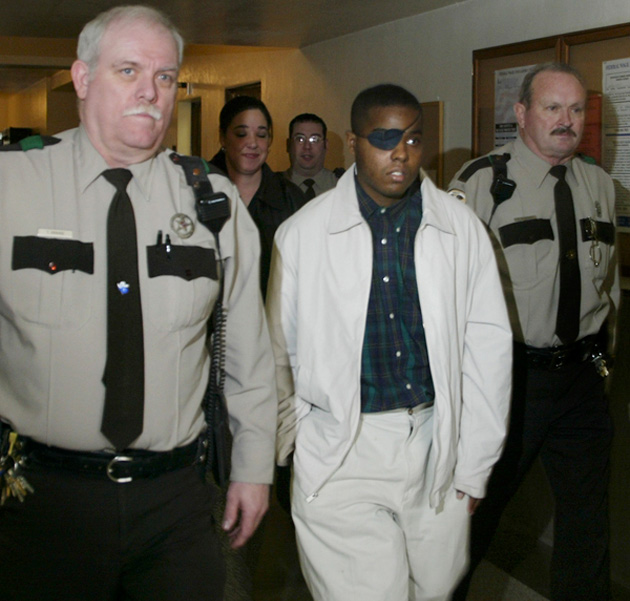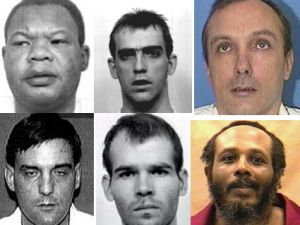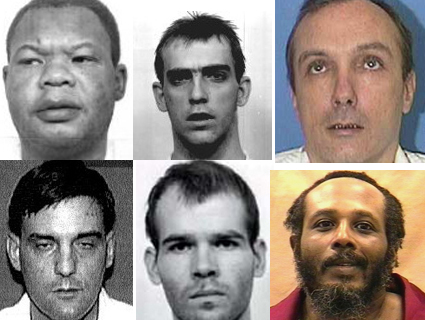
Chris Jennings/Herald Democrat
Years later, after Andre Thomas had been convicted of killing his estranged wife, his 4-year-old son and her 13-month-old daughter in the most bizarre case in Grayson County history, after he had received a death sentence and been told that it would be imposed at the appropriate future time, after he had been dispatched to Texas’ death row to wait his turn with the other condemned men and women, the prosecutors were still talking about “the eyeball issue.”
Certainly there were other details that made the crime uniquely memorable. For one thing, Andre had cut out the children’s hearts and returned home with the organs in his pockets. For another, he was careful to use three different knives so that the blood from each body would not cross-contaminate, thereby ensuring that the demons inside each of them would die. He then stabbed himself in the chest, but he did not die as he had hoped. In fact, he was well enough to leave a message on his wife’s parents’ phone explaining that he thought he was in hell, and he managed to confess to the police what he had done before they took him in for emergency surgery.
The entire episode had biblical overtones—Andre had convinced himself that his wife was Jezebel, his son the Antichrist, and her daughter just plain evil. In short, the case had enough spectacular aspects to keep the most jaded of court watchers buzzing for months, but it was the eyeball issue that garnered most of the attention. And that was only the beginning.
But the beginning of the crime is never the beginning of the story. A case like this one doesn’t drop cleanly out of the sky, just as no one suddenly wakes up one day and decides to take an Uzi to the mall. Andre, who was raised in Sherman, Texas, a small town about 60 miles north of Dallas, had gnarled roots, and it was next to impossible not to trip over them. People like me, who do capital defense work for a living—and lest you be curious, I have never been an attorney for Andre Thomas—like to draw family trees, because patterns of mental illness and substance abuse and domestic discord and parental neglect tend to emerge from their branches like an old Polaroid developing on the kitchen table.
Andre’s family tree had all of these patterns going back two generations, and likely you could have gone back two more and found the same assortment of disabilities. This is not only true of stricken souls like Andre—take a look at the family trees of Ernest Hemingway, or the composer Robert Schumann, and you’ll see manic depression and suicide running through their branches as well. But Andre’s was more tortured than most. You’d have to look long and hard to find a pedigree more predictive of disaster.
Andre’s grandmother, Vivian, was already a full-blown drunk by her mid-teens, so it’s hardly surprising that she fell in with drunks as well. Johnny, Andre’s grandfather, beat Vivian regularly, occasionally threatened to kill her with his gun, and once pushed her to the ground when she was pregnant, breaking the foot of her child in utero. Johnny was vicious but also strange—one of Vivian’s children remembered the time he threw all the food in the house into the yard.
Vivian had never been selective with men. She had nine children with five of them starting at the age of 14. After Vivian left Johnny, she married a man named Walter Martin, and the pattern continued—heavy drinking and a steady diet of domestic violence. It was in 1973, during one of their battles, that Walter put a gun to Vivian’s head. Andre’s uncle Gregory, who was all of 17 at the time, tried to pull the gun away, and that’s when Walter shot him in the stomach, killing him. Walter would later boast that he “planted” one of Vivian’s children, and fully intended to “plant another one.”
Vivian’s daughter Rochelle, who was closest in age to Gregory, never recovered from his killing. She, too, drank heavily, suffered from depression, and according to her siblings was sexually molested by Walter. Rochelle was Andre’s mother, and that was half the genetic pie.
Andre’s mostly absentee father, Danny Thomas, came from practically the same background—generational alcoholism, violence, mental illness. One of his brothers suffered from alcohol-induced dementia. Another was locked up in a state mental retardation ward. Looking at both wings of the family side-by-side was like snipping away at a piece of folded paper in elementary school and opening it to find two identical sides of a snowflake.
But what did it all add up to when you stacked Andre’s background against the removal of people’s hearts? Alcohol, violence, mental illness, trauma—that isn’t an unusual background for a death row inmate. Cable TV and criminology courses are loaded with that sort of thing. It was the eyeball issue that made people realize this was more than just the most bizarre case in Grayson County history.
Yet even the eyeball issue, like the Polaroid on the table, was a slow-developing story. It probably started with Vivian, who claimed to have a gift from God—more of a torment, really. She believed she received divine messages through dreams and visions, only she “didn’t handle the gifts,” as one of her children recalled. “They handled her.” Vivian saw her talent as a line that one could approach but never cross—a line separating dreams and visions from madness and delusion.
It is almost certain that Rochelle, the next generation of the gifted, crossed that line. She, too, believed that she had been chosen to hear God’s messages—that her mother’s gift had been passed down to her. This proved a curse for her and Andre alike. God often told Rochelle what to do, and she was certain that He was telling her son as well.
Andre was the fifth of Rochelle’s six children—all boys. By the time he came along, in 1983, Rochelle already had sons by three different men. She moved around constantly, and often relied on a local church to pay her utility bills. Yet despite living in one of the most chaotic situations in which a little boy might find himself, Andre somehow thrived. He received outstanding marks in kindergarten and first grade, and was placed in his school’s “gifted and talented” program. His second-grade teacher described him as a “strong and delightful student.”
Andre’s mother, meanwhile, couldn’t even say where her son went to school—as she later testified, she had so many children she simply couldn’t keep track of them. This is not quite as absurd as it might sound: Thanks to his mother’s transience, Andre attended three different schools in three different cities in two different states—and that was just second grade.
Around third grade Andre started telling his friends, apparently in earnest, that he was Raiden, a character from the video game Mortal Kombat. Like his mother and grandmother before him, he was hearing voices. He made no secret of it. Lots of people knew that Andre suffered from what the professionals called “auditory hallucinations.” At 10, he attempted suicide by slitting his wrists. He would try again three years later, sawing at his arm with a butcher knife. Both attempts were prompted by Andre’s mother saying she should have aborted him.
He also began dabbling in petty crimes. When he was 11, he was charged with criminal mischief after damaging some golf carts, and later with theft for stealing a car and driving it into a ditch. He faced the consequences alone. No parent or guardian was on hand to support him when he first met with his probation officer to determine a case plan. His mother often would find excuses to miss the appointments, on one occasion telling the probation officer it was “too cold” for her son to be outside.
As Andre grew older, his grades slipped and he was forced to repeat seventh grade. He managed to climb back into the gifted and talented program, only to regress as his family life deteriorated further. When his mother told him of a plan to move the family to Oklahoma, he informed his probation officer, and a judge placed him in a juvenile detention facility. The justice system would become Andre’s surrogate parent, keeping tabs on his whereabouts and overseeing his affairs. He once asked the judge for a work permit so that he could pay off his restitution and court fees, only to be told that at 14 he was too young to work.

AT AGE 16, on top of all of his other problems, Andre became a father. He had been seeing Laura Boren for several years when Little Andre came along. He dropped out of school, earned his GED, and began doing various low-wage jobs—at one point digging graves at Sherman’s West Hill Cemetery. The couple found their own place for a while, but later ended up moving in with Laura’s parents, and then with Andre’s mother. They got married on Andre’s 18th birthday, and Rochelle kicked them out of her house two weeks later. With nowhere they could live together, the newlyweds parted ways. Laura took Little Andre back to her parents’ house and Andre moved in with his brother. After four and a half months, they separated for good.
Andre’s world, already tenuous, was falling apart. He lost some seasonal work mowing grass, and struggled to pay for heat and electricity. And because his place lacked utilities, Laura began scaling back his visits with his son. Andre remarked to his father that he was in a circle he couldn’t break out of.
He kept trying, though, and sought out counseling for his suicidal feelings and the voices that wouldn’t keep quiet. By the time he was 19, they were blaring in his head like a brass band in a nightmarish parade, and he had attempted suicide several more times. As the date of the murders approached, Andre’s behavior grew ever weirder. He stopped talking for days at a time, placing duct tape over his mouth. He fixated on the dollar bill, imagining a code for his salvation among its symbols.
Three weeks before the killings, he overdosed on Coricidin—a brand of cough medicine—and wound up at a mental health facility in Sherman, where he asked the staff to kill him. “Life is too much for me to handle,” he said. Somehow they let him leave on his assurance that he was going straight to a nearby hospital. When he failed to show up, a warrant went out for his immediate apprehension, but the police failed to enforce it.
Two days before the killings Andre overdosed again, and stabbed himself with a knife. He walked into the ER at the Texoma Medical Center, where an attending physician deemed him suicidal, and quoted him saying he was trying to “cross over into heaven.”
The doctor would later testify that Andre was “really mentally ill,” as if to stress that this wasn’t just your run-of-the-mill crazy person. And then there was this detail from the physician’s records: “Thomas,” he wrote, “is psychotic. He thinks something like Holodeck on Star Trek is happening to him.” If you don’t know what that is, and there is no good reason you should, a holodeck is a simulated reality facility—a place where nothing is real.
Finally, the patient wanted to know whether he had volunteered for his life, or been forced to live it. Maybe that was the final straw. The doctor referred Andre to the hospital’s mental health unit and filled out an emergency detention order to hold him against his will. But while staffers waited for a judge to sign the order, Andre simply wandered off. The hospital called the police, but there’s no evidence that officers went looking for him at the home of Andre’s mother or any of his other relatives. The next time they saw him, he was walking into the Sherman police station to confess to killing his family.
You might wonder what Andre was thinking when he removed the children’s hearts and placed them in his pockets to take home—along with a piece of Laura’s lung, which he mistook for her heart. By his own account, he had received a message from God telling him to kill Jezebel, the Antichrist, and a related evil spirit. The only other clue was the dollar bill he had folded lengthwise and left next to his wife’s leg, exposing the pyramid with the eye at the top.
Pull out a dollar bill and look at the back for yourself: Above the eye are the words Annuit Coeptis: “He approves our undertakings.” It’s likely you haven’t thought much about this, but Andre did—for hours at a time. Maybe he was seeking approval, and the dollar bill served to confirm the words that kept pounding in his head. But two days later, when he was confessing his crime to the police, he called the eye at the top of the pyramid “evil.” A day after that, he explained that he was the “thirteenth warrior on the dollar bill.” (It just so happens that there are 13 steps on the pyramid for the 13 original states, but no reference to warriors.)
A further explanation followed: According to the notes of the nurse who was monitoring Andre in his glass-walled observation cell at the Grayson County jail, his wife and kids weren’t really dead. He had removed their hearts to free them from evil.
Andre refused the anti-psychotic medication the jail doctors prescribed him, but at least he had the Bible, and when he wasn’t acting belligerently or gesticulating wildly or ranting about evil he would read from it. One can only wonder what he thought when he turned to Matthew 5:29—particularly in light of his obsession with the eye on the pyramid. “If your right eye causes you to sin,” the passage reads, “gouge it out and throw it away. It is better for you to lose one part of your body than for your whole body to be thrown into hell.”
And that is precisely what Andre did. Sitting in his cell, reading the Bible, he gouged out his right eye with his fingers. Had it finally dawned on him, six days after the killings, what he had done?
THERE IS A WORD for almost everything in this world, and there is a word for the intentional removal of one’s own eye: auto-enucleation. What little medical literature exists on this malady states the obvious: It is an extraordinarily rare form of self-mutilation brought about by extreme psychosis. It occurs with paranoid delusions, often of a religious nature, that accompany schizophrenia, and is occasionally referred to as Oedipism.
The reference, of course, is to the myth of Oedipus the King, who blinds himself after learning that he has fulfilled a prophecy by murdering his father and sleeping with his mother. For Oedipus, it is not schizophrenia or delusions, but rather his own guilt and the merciless Fates that cause him to stab out his eyes. Yet even blinding himself can’t save him: “I know death will not ever come to me through sickness or in any natural way,” he laments at the end of the Sophocles play Oedipus Rex. “I have been preserved for some unthinkable fate.”
When Andre took his eye out, the legal proceedings stopped in their tracks. Who knew what the man might say or do in front of 12 jurors? For starters, the authorities quickly equipped him with big mittens—fastened to his wrists to prevent their removal—to protect his other eye. Three doctors evaluated him—one from the jail, one appointed by the court, and one brought in by the state. All of them said that Andre suffered from some form of schizophrenia. He was declared incompetent for trial and shipped off to the secure wing of North Texas State Hospital, where he continued to hear voices and talk to himself, and seemed to have a recurring dream where scorpions and tarantulas were trying to eat him.
But this wasn’t the sort of case likely to fade from public view. Maybe that was why Andre’s diagnosis was changed during his stay at the state hospital. At the end of 47 days of evaluations and medications, the doctors concluded that most of his hallucinations were substance-induced. His discharge order seems contradictory: The doctors said Andre was malingering by exaggerating his mental illness, and yet they made him wear the mittens throughout his stay. They also noted that he was consistently cooperative with staff, behavior that is not at all typical of malingerers. Andre was now competent to stand trial, they wrote, and the court so found.
Still, the eyeball issue had gotten everybody’s attention. At one point the district attorney of Grayson County had called it the desperate act of a man who feared punishment, but as the trial date approached, the prosecution seemed more circumspect. After all, the defense would surely argue that Andre was insane, and could even the most hardened DA argue that he was faking it—that he had scooped out his own eye to manipulate the jury?
For the prosecution, one big decision remained: Would the state seek the death penalty? After all, no murder, no matter how heinous, depraved, or just plain bizarre, requires it. Ever since the Supreme Court outlawed mandatory death sentences 37 years ago, these decisions have been left to the prosecutors. In Texas, district attorneys have used their discretion broadly, not only in seeking the death penalty but also in making sure it is carried out. The Lone Star state alone is responsible for 37 percent of all executions in the United States since 1977, when the death penalty came back into vogue.
But discretion has its limits. Race, for one, cannot be considered at all. Not to say it never is—just that it is unconstitutional to do so. Yet race tends to play a big role in capital cases, especially ones like the Thomas case, where the victim is white and the defendant is black.
Laura Boren Thomas, Andre’s late wife, was white. The children he killed were mixed race. These facts were particularly important when it came to jury selection. Under questioning by the lawyers, 4 of the 12 eventual jurors said they were opposed to people of mixed-race backgrounds marrying and/or having children. One even stated that he did not believe “God intended for this.” Andre’s court-appointed lawyers did not object, and the jurors were seated.
In fact, for this particular jury selection, the prosecutors invoked an option available only in Texas. It’s called the “shuffle.” The pool of potential jurors, known as a venire, are seated in a room, and with no information other than what the jurors look like, either side can request that they be shuffled—reseated in a different order.
The order of the venire, it turns out, is crucial to the jury’s final makeup. That’s because each juror is questioned in turn, and if lawyers from either side want to exercise their right to disqualify someone, they have to do it then and there. If it looks like one side is striking a juror based on race—which is not allowed—the other side can mount a challenge. Hence the shuffle: At Andre’s trial, there were initially six African Americans seated in the first two rows. After the shuffle—which proceeded without any objection by the defense—there were no blacks in the first five rows. Ultimately, two black jurors were questioned and dismissed. When all was said and done, the entire jury—not to mention the judge and all of the lawyers—was white.
IT’S FAIR TO SAY that race played a role in more than just the jury selection. The crime and the trial both took place in Sherman, a town still remembered for a shocking lynching and subsequent race riot back in 1930. In the spring of that year, a black farmhand named George Hughes was accused of raping a young white woman. He surrendered to the police, and a trial was set for six days later.
False rumors that the woman had been mutilated spread across the town, and on the morning of trial, as many as 5,000 people descended on the Grayson County courthouse hell-bent on revenge. As the trial commenced, the mob battled with state police and set the building on fire. Hughes, who had been placed in a county vault for his protection, died. The townspeople pulled his corpse into the street, dragged it behind a car, and hung it from a tree. In the mayhem that followed, most of the town’s black businesses, and one residence, were burned to the ground. The governor imposed martial law, and for two weeks the state militia took over the town. Sherman’s black community never fully recovered from the trauma—for the next 65 years, not a single black doctor or lawyer practiced within its boundaries.
It was here, in Sherman, that Andre Thomas not only married a white woman, but became friends with a number of others, who showed up at the sentencing to testify on his behalf. This did not go unnoticed by the prosecutor. In the last sentence of his closing argument in favor of the death penalty, he mentioned the “string of girls that came up here,” and asked the jurors if they were willing to risk Andre “asking your daughter out, or your granddaughter out?”
Statements like these tended to distract the jury from the more pressing question of Andre’s mental health problems. Given the grisly details of the crime—and the eyeball incident—more than a few observers were undoubtedly left wondering just how crazy a person could be and still face execution.
There is no simple answer to this question. State courts across the country have struggled to define “intellectual disability” (also known as mental retardation) since 2002, when the Supreme Court ruled that retarded people are exempt from capital punishment. The high court has also banned the execution of anyone who was under 18 at the time of his crime, but no court has ruled that severe mental illness makes a person ineligible for the death penalty.
The Supreme Court’s latest foray into the issue involved the case of Scott Louis Panetti, another Texas death row inmate. Panetti, a diagnosed schizophrenic who killed his in-laws, defended himself in court wearing a purple cowboy suit. As if that weren’t enough, he asked to subpoena Jesus, John F. Kennedy, and the pope. While the justices didn’t offer any clear standard on how crazy is too crazy, they suggested that severe mental illness might render someone’s “perception of reality so distorted” that he cannot be constitutionally executed.
As it stands, a person cannot be put to death if he or she is deemed “insane,” but that’s a narrow legal distinction. Whether at trial or on the eve of execution, an insanity defense hinges on a defendant’s inability to connect his crime with the consequences. Absent that connection, neither deterrence nor retribution is served by execution. As the legal scholar Sir William Blackstone put it more than 200 years ago, madness is its own punishment.
Almost every state, including Texas, now utilizes some version of what is known as the M’Naghten Rule. Daniel M’Naghten, an Englishman, was put on trial in 1843 for fatally shooting a civil servant he apparently mistook for the prime minister. He had delusions of persecution, and a number of doctors testified that he was unable to hold himself back. When the prosecution produced no witness to say otherwise, M’Naghten was found not guilty by reason of insanity. He spent most of the rest of his life at the State Criminal Lunatic Asylum in London’s Bethlem Royal Hospital, which locals pronounced “Bedlam.”
Thus was coined a word we associate with chaos—and it was chaos that ensued when M’Naghten was acquitted and the public took the verdict poorly. What emerged amid the outcry was the generally applied law that an insanity defense would only be available to someone who cannot understand the “nature and quality” of his act.
Andre’s trial hinged on this very question, but with one wrinkle. In Texas, if your insanity is caused in any way by voluntary intoxication, you cannot use it as a defense. The prosecution’s doctor-experts testified that Andre was well aware he was behaving wrongly, and that his crimes may have been triggered by his cough medicine overdoses, drinking, and pot smoking.
The defense called to the witness stand doctors who pointed to Andre’s history of mental illness apart from any substance abuse. And hadn’t the man removed his own eye!? Was the state seriously suggesting that Andre’s auto-enucleation was a ruse? No. Instead, the prosecutors argued that it “was an impulsive act.” They didn’t dwell on it, of course. There’s no requirement that attorneys have to spend lots of time talking about evidence that hurts their case. They just said it was an impulsive act, and moved on.
The jury moved on with them, and Andre’s insanity plea was rejected. He was found guilty and, four days later, sentenced to death. It turned out that an impulsive act, even coupled with orders from God and the removal of hearts, could not soften the punishment for murdering three in Grayson County. And so, less than a year after killing his family, Andre went off to death row.
THE STATE’S CONDEMNED live in the Allan B. Polunsky Unit, just outside of Livingston, Texas. It looks as one might imagine a death row would look—a series of imposing concrete structures surrounded by excessive razor wire and four guard towers.
The Polunsky unit didn’t become death row until 1999, after seven inmates tried to escape from the old facility. At the time, the Polunsky unit was called the Terrell unit, after Charles Terrell, a Dallas insurance executive and a former board chairman at the Texas Department of Criminal Justice. But when it became death row, Terrell asked to have his name removed. He was uncomfortable being associated with capital punishment because he had problems with how it was administered.
Almost a decade later, Terrell would sign a letter supporting a state moratorium on the death penalty. The letter laid out his concerns about racial fairness in some parts of Texas, the absence of DNA testing when it was possible to do it, and his opinion that life without the possibility of parole was in fact more punitive for young offenders than a death sentence. He added that he was the only person he knew of who ever had his name removed from a building. Documents generated by the prison system in the Thomas case, however, still read “facility POLUNSKY (formerly TERRELL).” In one final touch of irony, Terrell was born in Sherman.
Death row is not designed for rehabilitation. There are no programs to attend, no degrees to obtain. The main business carried on is waiting. Those lucky enough to come to the row mentally intact may be able to hold themselves together through the years of aloneness by reading, talking to prisoners in nearby cells, or listening to the radio. But inmates like Andre, who are already debilitated by mental illness, do not get better. There are no avenues for it. The cells at Polunsky are smaller than a basketball free-throw lane, the prisoners are on lockdown more than 90 percent of the time, and there is no human contact at all. Andre still wore the mittens to protect his remaining eye, and his meals were brown-bag because he couldn’t be trusted with utensils. He was taking the same medication he had been taking at the state hospital.
His diagnosis on death row, paranoid schizophrenia, was not the diagnosis prosecutors had argued to the jury that put him there, but the prison records said “no stop date indicated” for his medication. In short, the DAs could argue whatever they wanted to avoid an insanity verdict, but this guy was, as they sometimes say in Texas, “crazy as a peach-orchard boar,” and prison officials were going to treat him as such.
Every once in a while there were skeptics. Like the doctor who didn’t trust Andre’s hallucinations because the voices always told him to “do things he wants to do anyway. People who have hallucinations do not recognize they are hallucinations.” Prisons, of course, are houses of skepticism. Consider this entry from an early psychological intake form: “R eyelid is in a fixed, closed position. R eye seems to be missing (as pt claims).” Apparently the mittens weren’t enough of a giveaway.
And so it went from March 2005 to the summer of 2008—lots of complaints from Andre about the voices, an attempt at cutting himself with a razor blade, and the periodic suggestion that he was faking the whole thing. Mostly, though, the prison records depict a barely-getting-by paranoid schizophrenic who knows he is seriously mentally ill but doesn’t have any idea what to do about it. Sometimes the voices would scream at him to “bash my head,” as he put it. Other times he thought six-inch demons were coming out of the walls and playing music by the rock group Queen. And then there were days that he said he felt fine and was writing music for his mother.
On July 14, 2008, Andre managed to procure something sharp and slash a seven-centimeter gash in his throat, requiring eight stitches. He insisted that he was the cause of all the problems in the world, and that if he killed himself all the problems would stop. The next day, he reported that he had been reading his Bible and got confused because he wasn’t sure if it was the voices or his own thoughts that were telling him to kill himself. During a psychiatric assessment one week later, he explained that “The government is conspiring to read my mind. That’s why I ripped out my right eye. That’s the righteous side. They can’t hear my thoughts no more. I cut my throat. Gotta shed a little blood to save the world. Like the guy in the dayroom told me, “Don’t lighten up, tighten up!'”
Prison officials were concerned enough to send him to the system’s psychiatric facility, but they returned him to his regular cell within a month. It was only eight stitches, and he clearly could have inflicted far more damage.
Then again, maybe the episode signaled the start of another slide. After three years on the row, there was little question that Andre was getting worse. Or maybe it’s more accurate to say that events were beginning to recur again. Andre had always believed in what we all call déjà vu—except he was convinced that he was reliving days and weeks in their totality. A year prior to the killings, he complained to friends that life kept repeating itself. And since things were happening over and over again, it meant they weren’t really happening at all. Shortly after his crime, when he explained to the nurse that his wife and children weren’t really dead, he had said, “This is déjà vu from all reality.”
By late that fall, Andre was acting much as he had in the weeks leading up to the crime. He felt suicidal again and asked for help, but refused to take his meds. He stopped talking and wouldn’t eat. He came out to see his lawyer with Scotch tape clumsily covering his mouth, and insisted on writing his answers to her questions on a glass partition with his finger. It’s conceivable that Andre’s relapse was related to an incident in late November, when he found himself in a cell next to an inmate who swore he was the Antichrist. This enraged Andre, who believed he had already done God’s work in removing the Antichrist from the earthly realm.
Perhaps what he did next—the thing that got everybody’s attention again—resulted from a combination of all these things: On December 9, 2008, Andre ripped out his left eye. His only eye. And he ate it.
As he explained some days later, he didn’t want the government to read his thoughts, so he ate the eye because he was certain they would figure out some way to put it back in. He said he had been reading the Book of Revelations, and felt sympathy for the devil because it wasn’t all Satan’s fault. After all, Andre was supposed to have been aborted.
AFTER THE SECOND eye removal, it was clear that the Polunsky unit was no longer the appropriate home for Andre. He was packed off to Jester IV, a state prison psychiatric unit. As the name implies, Jester IV is one of a series of Jester units, all located in Richmond, Texas, just southwest of Houston. The complex is surrounded by cornfields. Indeed, the property once hosted the Harlem Plantation, which became a prison farm in the late 1800s. It was renamed in honor of former Gov. Beauford H. Jester, who served from 1946 to 1949, and was in the process of reforming the state prisons when he died in office of a heart attack.
There are a few other death row inmates at Jester IV, but the unit is reserved for the mentally ill. Andre is still locked in a small cell 23 hours a day, but by all accounts Jester IV is a quieter place. He seems more comfortable around other mentally ill prisoners, and he does not believe, as he did at Polunsky, that they are scheming against him. He hasn’t yet learned to read Braille, and the medicine he is on now tends to knock him out for large portions of the day. While he is awake he often breaks into song. He is a big fan of Depeche Mode.
Joe Brown, the district attorney of Grayson County, said he was surprised to hear that Andre had removed his second eye, but he did not call it a second impulsive act. He simply announced that the state would gather together Andre’s records and evaluate the situation.
The records themselves are remarkable if only to show how acceptable bizarre thoughts can become in a prison psychiatric setting. Eight days after swallowing his remaining eye, for example, Andre reports that he is hearing voices, including that of God, and says the government has the eye he didn’t eat and he wants it back. The evaluation form accompanying these remarks indicates that he is not presenting delusional or paranoid symptoms, and that his “insight/judgment” is fair. Other records are similarly disingenuous.
Four years have passed since the second eyeball incident, but Andre’s prosecutors have not reported back about their record-gathering or any subsequent evaluation. Texas continues to forcefully pursue Andre’s execution. No state authority figure has expressed hesitation about ending the life of a man who intentionally blinded himself, nor has there been any move by the district attorney to reconsider Andre’s mental state at the time of the killings.
The only one who has revisited the issue, apart from the lawyers who are now appealing his sentence in the Texas federal courts, is Andre himself. He spoke about it with a nurse shortly after he slashed his own throat—back when he still had one eye to see with: “I killed my wife and two kids,” he said. “My wife was Jezebel. God told me to, so I cut out their hearts. I fucked up though: I heard another voice. I thought it was God, so I listened. It told me not to complete the ritual and don’t burn the hearts. So, I threw them out.” This failure, he explained, would bring consequences: “Before 2012, they will come back and be mad I killed them.”
But now it is 2013. His family hasn’t come back, and won’t. Andre Thomas remains in his tiny cell on death row, waiting. And no one, not even Andre, is quite certain what he is waiting for.

















